Old Furniture: Clean, Reupholster or Replace It?
http://decor-ideas.org 07/22/2014 23:15 Decor Ideas
Let’s say your mother-in-law has purchased a brand-new shiny sofa, and has deposited her aging original one in your front room. Or you’ve scored a once-in-a-lifetime roadside find — a Louis XVI chair with a magnificent frame but questionable fabric. Or, much to your dismay, your favorite couch has become soiled, saggy or sunken.
What do you do? Do you clean the piece, reupholster it or replace it?
I sought advice from Alec Houle, who has more than 50 years’ experience cleaning carpets and upholstery. There simply isn’t much out there in the upholstery industry that he hasn’t seen.
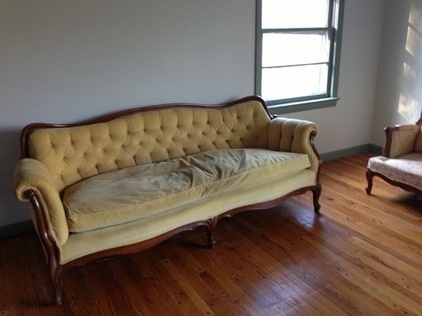
History
Houle’s first questions when shown a sofa or a chair are, “Where did it come from? What’s its history? Did you get it from family, a friend or a stranger?”
With family or even a friend, you can get a little honest history about the piece, like the quality, the original cost, its age and what conditions it may have been subjected to. The same often holds true with a piece you obtain from a garage sale or secondhand store. But with a roadside rescue, it’s anybody’s guess what indignities your upholstered piece may have endured.

Condition
Of foremost concern is whether the piece you are pondering lived with smokers. If it did, residual smoke has gone into the fabric and is now in the linings or even the wooden frame. You may never get rid of the smell.
Second, did the sofa or chair spend time in a basement or garage? These spaces are notorious for a high level of humidity and dampness, which can result in a musty smell, which is caused by mold. Mold loves to grow on any material that comes from a plant, like linen, cotton or wood. All it needs is a temperature above 50 degrees with high humidity or moisture present. Lack of light can also accelerate its growth. So the moisture and humidity are absorbed into the wooden frame, and you have all the ideal conditions for mold growth.
The only way to deal with this is to totally strip the piece down to the frame, treat the wood for mold and then start rebuilding. Do you see dollar signs?
Third, was the furniture ever in storage or any other place where it could have been infested by insects, like bedbugs? (Ewww … )
Any of these conditions means it is the better part of valor to kiss the piece goodbye. New upholstery is in your future.
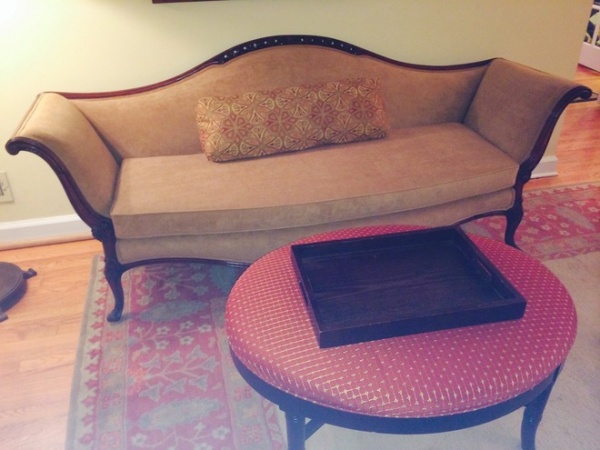
If your piece passes all the history and condition tests and you are going to keep it, not replace it, your next decision is: Do you clean it or have it reupholstered?
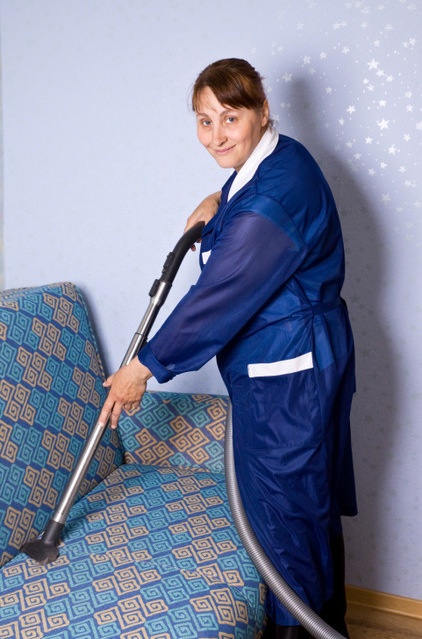
Cleaning
If the amount of staining or soiling is not inordinate, and if the piece seems to work with the overall design theme of your room, cleaning should be one of the first options to consider. But cleaning opens a whole new can of worms.
Houle has been cleaning upholstery for 52 years. He has an extensive background in fibers and chemistry, and feels fairly capable of judging — prior to cleaning an upholstered piece — how well it will come out. But even he is sometimes surprised. And he’s quick to point out that there is no guarantee that your sofa can be cleaned to your satisfaction.
That said, considering that his charge to clean an average sofa is $90 (the cost will vary by region), it might be well worth the expenditure to bring a piece of furniture back to its original appearance.
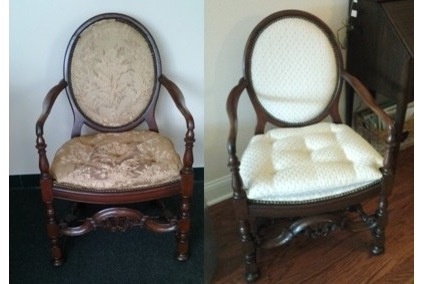
Reupholstering
However, in my 40 years of designing, I don’t think I have ever found or been given a piece where the existing fabric was to my taste. Enter our third option: reupholstering. But before we go there, be aware that the cost of reupholstering can range from the sublime to the ridiculous, and there are tons of variables. Are you going to spend $40 a yard on fabric or $200? Do you live in a big city or a tiny hamlet? The part of the country you live in will have a big impact on what you pay for labor.
Bottom line: You should expect new upholstery to cost you about the same as buying a comparable new piece. That said, this chair shows how really gratifying reupholstering can be.
If you would like to know more about the perks and perils of reupholstering old furniture, check out my ideabook on the subject.
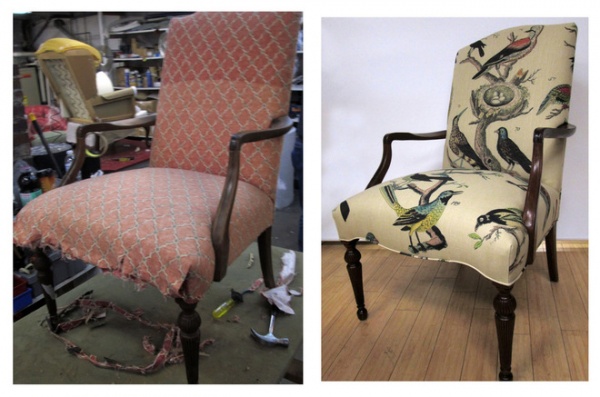
Here’s another example of successful reupholstering.
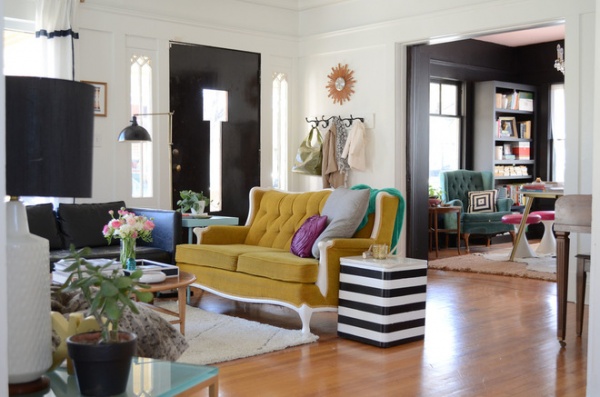
A vintage sofa like the one shown here might have looked like a fussy, old wood-framed sofa when Grandma dropped it off. But because you are confident of its history, some paint and new fabric make it incredibly chic.
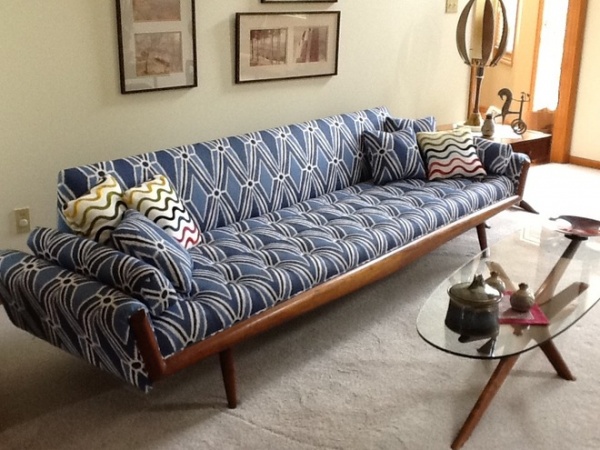
This isn’t just limited to Grandma’s stuff. Check out what new fabric did for this stunning midcentury sofa.
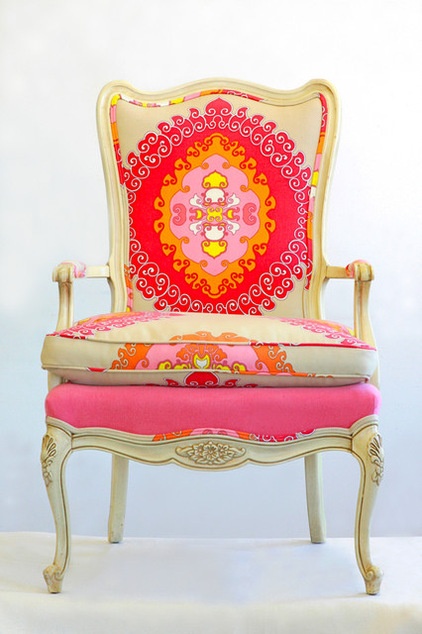
Fabric
We are nowhere near done dealing with this particular cans of worms, because we still have to pick a fabric.
Houle is once again a fountain of wisdom. First, he suggests considering where the piece will be used. Will it be in a formal living room, or in a family room with heavy daily use? Is it for a woman living alone, a family with three kids or a couple with multiple dogs?
Natural fibers like cotton, linen and silk are very desirable because of their look and feel. But durability and cleanability are not their middle names. So they are best used in more formal or lightly used rooms.

Synthetic fabrics will hold up better under heavier usage and are generally more cleanable. Some popular examples of these are Ultrasuede and other microfibers — all of which are solution-dyed polyester fiber. These fabrics are great for kids and pets.
Outdoor fabrics like those by Sunbrella are also solution dyed and can be a great choice for heavy-use rooms. This living room is used for everything in this home, including socializing and watching TV. The 20-year-old furniture was refreshed with beautiful, new, durable fabrics, to great effect.
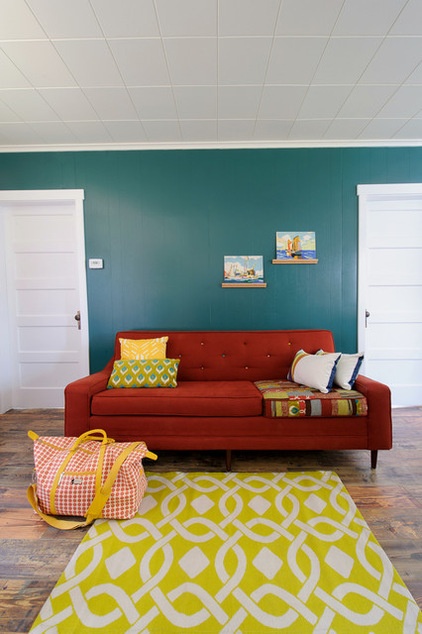
New upholstery opens the door to fabrics and combinations you would never find on a showroom floor — like the creative and fab use of bright fabrics in defined sections of this sofa …

… or the Barbara Barry fabric that makes this curvy sofa the star of this living room revival!
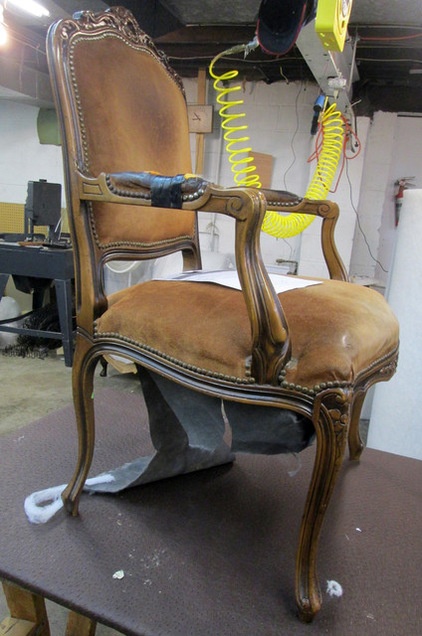
Leather
Let’s end with a quick discussion on leather. Houle simplifies the leather issue by breaking the material into three groups: protected, aniline and nubuck.
Protected leather has a high sheen and is fairly cleanable and easy to maintain, but the finish will crack over time. Aniline and nubuck have a nicer feel and are a higher quality of leather, but cleaning is much harder and stains can be nearly impossible to remove.
If you are going to reupholster in leather, you need to consider cost as well as the practical application. Generally speaking, if you really want leather, just buy a new piece of furniture — it is much more cost effective.
If you would like to ask Alec Houle a question, you can use the Ask Alec link on his web page.
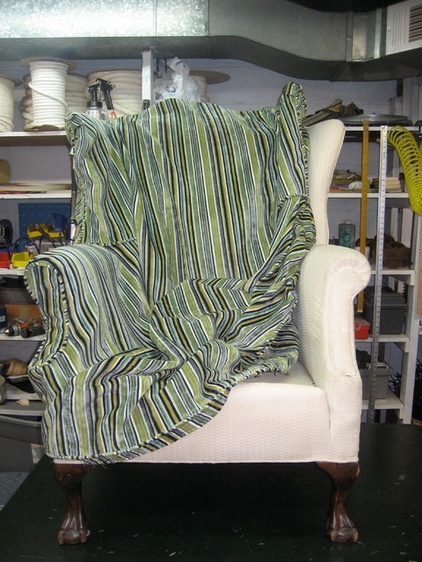
Slipcovers
No, I have not forgotten slipcovers, which can be a great option for refreshing furniture. But that is a discussion for another time.
More:
Get the Upholstery Work You Expect: 10 Details to Discuss
Abraham Lincoln Sat (and Flirted) Here
Related Articles Recommended












